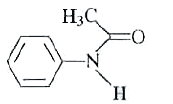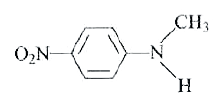Which of the following is strongest Bronsted base?




The correct Answer is:D
To determine which of the given compounds is the strongest Bronsted base, we need to analyze the availability of the lone pair of electrons on the nitrogen atom in each compound. The more available the lone pair is for donation, the stronger the Bronsted base it will be.
1. Identify the Compounds: We have four compounds to analyze. Let's denote them as Compound A, Compound B, Compound C, and Compound D.
2. Analyze Compound A:
- The lone pair on the nitrogen in Compound A is involved in resonance with double and single bonds in the molecule.
- This resonance delocalizes the lone pair, making it less available for protonation (donation).
- Conclusion: The lone pair is not available for donation.
3. Analyze Compound B:
- Similar to Compound A, the lone pair on nitrogen in Compound B is also involved in resonance with a benzene ring.
- The resonance again reduces the availability of the lone pair for donation.
- Conclusion: The lone pair is not available for donation.
4. Analyze Compound C:
- In Compound C, the lone pair on nitrogen is involved in resonance with the benzene ring and is also affected by an electron-withdrawing NO2 group.
- The NO2 group has a -M (minus mesomeric) effect which pulls electron density away from the nitrogen, further reducing the availability of the lone pair.
- Conclusion: The lone pair is not available for donation.
5. Analyze Compound D:
- In Compound D, the lone pair on nitrogen is also involved in resonance with the benzene ring.
- However, there is a methyl (CH3) group present, which has an inductive effect that can slightly increase the availability of the lone pair for donation.
- Since there is no strong electron-withdrawing group like NO2 present, the lone pair is relatively more available compared to the other compounds.
- Conclusion: The lone pair is somewhat available for donation.
6. Final Comparison:
- Compounds A, B, and C have their lone pairs significantly delocalized and thus are poor Bronsted bases.
- Compound D has a lone pair that is less affected by resonance and is more available for donation due to the inductive effect of the CH3 group.
Final Answer:
Compound D is the strongest Bronsted base among the four options.
---
- The lone pair on the nitrogen in Compound A is involved in resonance with double and single bonds in the molecule.
- This resonance delocalizes the lone pair, making it less available for protonation (donation).
- Conclusion: The lone pair is not available for donation.
- Similar to Compound A, the lone pair on nitrogen in Compound B is also involved in resonance with a benzene ring.
- The resonance again reduces the availability of the lone pair for donation.
- Conclusion: The lone pair is not available for donation.
- In Compound C, the lone pair on nitrogen is involved in resonance with the benzene ring and is also affected by an electron-withdrawing NO2 group.
- The NO2 group has a -M (minus mesomeric) effect which pulls electron density away from the nitrogen, further reducing the availability of the lone pair.
- Conclusion: The lone pair is not available for donation.
- In Compound D, the lone pair on nitrogen is also involved in resonance with the benzene ring.
- However, there is a methyl (CH3) group present, which has an inductive effect that can slightly increase the availability of the lone pair for donation.
- Since there is no strong electron-withdrawing group like NO2 present, the lone pair is relatively more available compared to the other compounds.
- Conclusion: The lone pair is somewhat available for donation.
- Compounds A, B, and C have their lone pairs significantly delocalized and thus are poor Bronsted bases.
- Compound D has a lone pair that is less affected by resonance and is more available for donation due to the inductive effect of the CH3 group.
Compound D is the strongest Bronsted base among the four options.
Similar Questions
Knowledge Check
Which of the following is the strongest Bronsted base ?
A B
B C
C D
D
Which of the following is the strongest Bronsted base ?
A B
B C
C D
D
Which of the following is the strongest Bronsted acid ?
A B
B C
C D
D
Which of the following is the weakest Bronsted base?
View SolutionWhich of the following is the strongest base ?
View SolutionWhich of the following is the strongest base ?
View SolutionWhich of the following is the strongest Bronsted acid ?
View SolutionWhich of the following is the weakest Bronsted base?
View Solution
